
Military Spendings by Countries in the 21st Century.
The Changing Landscape of Military Spendings
In the 21st century, military spendings have become a significant aspect of global politics and economics. Countries around the world allocate a substantial portion of their budgets to defense and security, aimed at maintaining their sovereignty, protecting their citizens, and projecting power on the international stage.
However, the distribution of military spendings varies greatly among nations, reflecting their unique geopolitical circumstances, threat perceptions, and strategic interests. In this blog post, we will explore the trends and patterns of military spendings by countries in the 21st century.
The Top Military Spenders
When it comes to military spendings, a few countries stand out. The United States consistently tops the list as the largest spender, accounting for more than a third of the world’s total military expenditures. Its defense budget is unparalleled, driven by its global military presence and technological advancements.
China follows closely behind, rapidly increasing its military spending to modernize its armed forces and assert its regional influence. Other major military spenders include Russia, India, and Saudi Arabia, all investing heavily in their defense capabilities.
Regional Disparities
While some countries spend exorbitant amounts on defense, others struggle to allocate adequate resources due to economic constraints or peaceful geopolitical environments. In Europe, for example, NATO members commit to spending at least 2% of their GDP on defense, but many fail to meet this target.
On the other hand, countries in conflict-prone regions such as the Middle East and North Africa often allocate a significant portion of their budgets to defense due to ongoing security threats. This creates regional disparities in military spendings, with some areas heavily militarized while others remain relatively underfunded.
Emerging Trends
The 21st century has witnessed several emerging trends in military spendings. One notable trend is the increasing emphasis on technological advancements, such as cyber warfare capabilities, unmanned aerial vehicles, and artificial intelligence. Countries are investing heavily in research and development to maintain a competitive edge in the modern battlefield.
Another trend is the growing importance of soft power and non-traditional security challenges. Nations are allocating resources to counter terrorism, address climate change, and respond to global pandemics. These non-conventional threats require a different approach and necessitate a reallocation of military spendings.
The Economic Impact
Military spendings have significant economic implications. While defense industries benefit from government contracts and investments, excessive military expenditures can strain national budgets and hinder investments in other sectors such as education, healthcare, and infrastructure.
Furthermore, the arms race between countries can lead to an escalation of tensions and potential conflicts, disrupting global stability and impeding economic growth.
Conclusion
In conclusion, military spendings by countries in the 21st century reflect a complex interplay of geopolitical factors, regional disparities, emerging trends, and economic considerations. As the world continues to evolve, it is essential for nations to strike a balance between defense requirements and other societal needs, fostering stability, cooperation, and sustainable development.
Have a query? Contact Us
